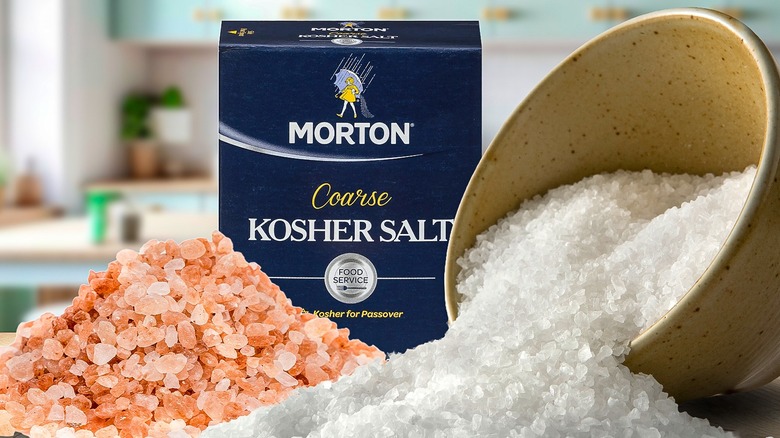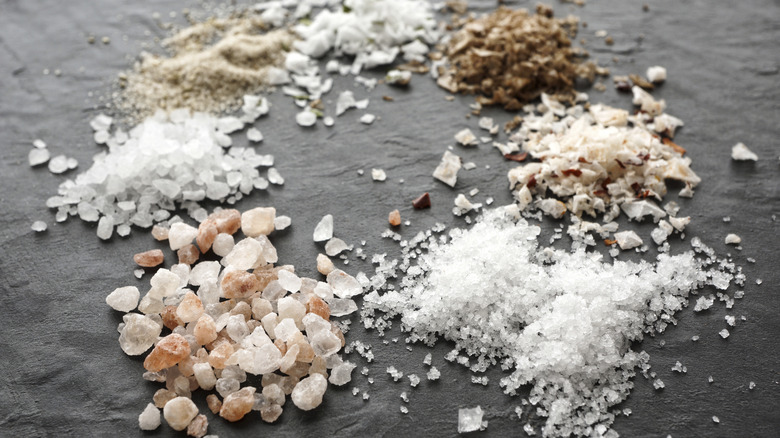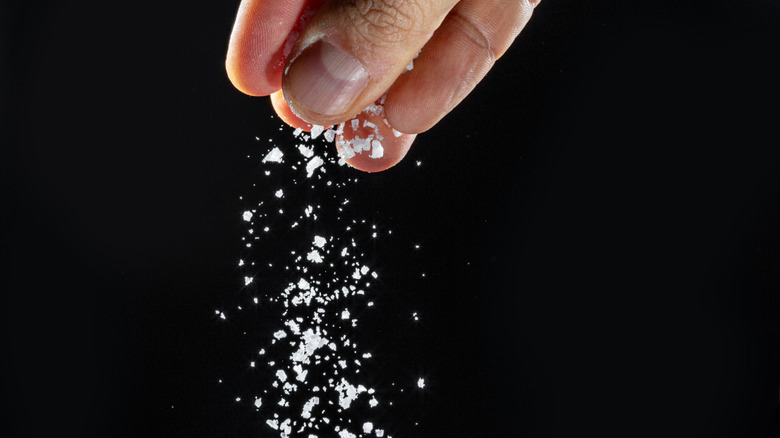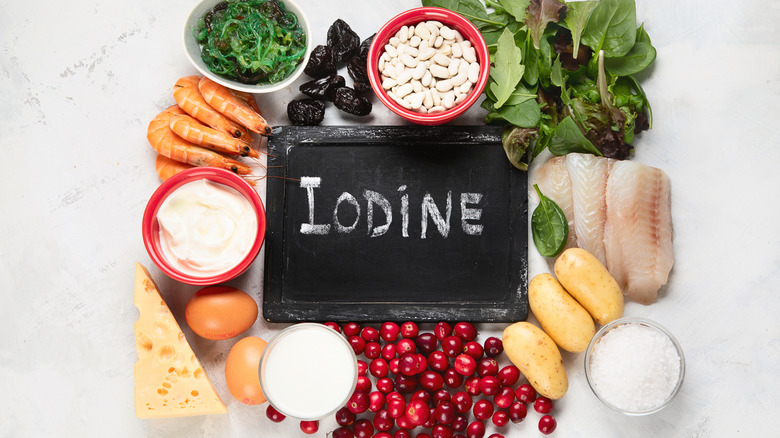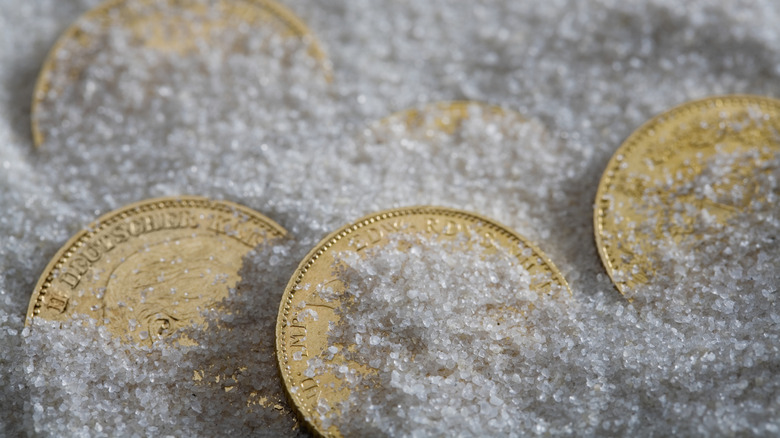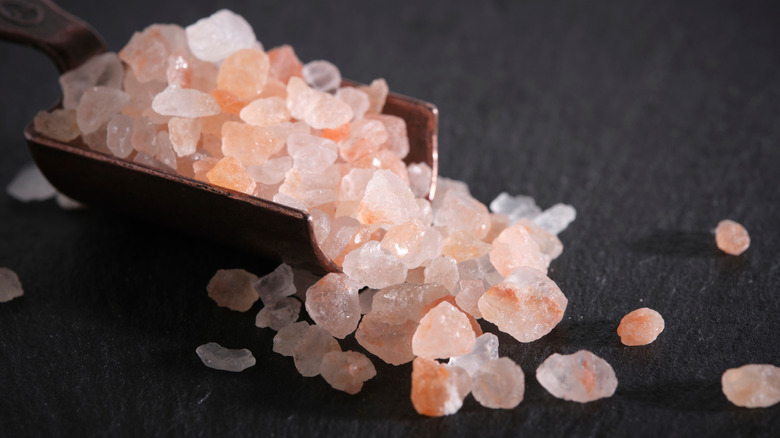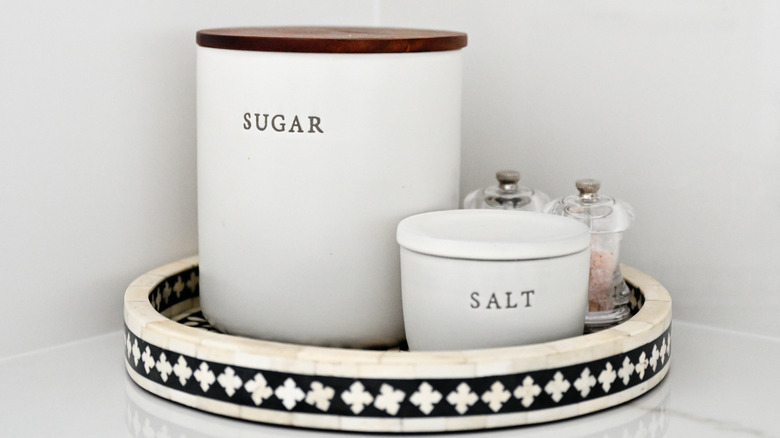8 Truths About Salt You Haven't Heard Yet
Salt doesn't seem like the most exciting ingredient. Yes, it's crucial in cooking, and it's essential to human health; despite warnings about ingesting too much sodium, you do need at least some to prevent a potentially fatal condition called hyponatremia, in which your blood's sodium level is too low for your body to function properly. But most people don't give salt, in general, much more thought.
That's a shame, because salt has a much longer and more intricate history than many realize. Not only has it been a source of financial wealth and religious devotion in the past, but it's changed the economic and political fortunes of numerous countries, including the U.S. Its use or non-use has more of an effect than just changing the taste of food. Salt even helps keep people safe in wintry weather. If you've never spent much time musing about salt, listen up; here are eight truths about salt you haven't heard yet.
The size of a salt crystal matters for cooking and baking
When you look at a recipe, you'll often see salt listed as sea, kosher, or another type. If you see only "salt" listed, then the source you got the recipe from will most likely have a paragraph somewhere that states which type of salt to use in all its recipes. This is done because different types of salt have different crystal or grain sizes, and those make a difference in how your final dish turns out. Table salt, for example, is very fine, with small crystals that settle easily into whatever measuring tool you're using. Sea salt may be fine, or the grains might be a tiny bit larger; some varieties of sea salt, like Maldon, have relatively large crystals. And then there's kosher salt, with its huge grains.
Table salt's small grains mean more will fit into a measuring spoon; kosher salt's larger grains mean fewer fit in the same spoon. Add a teaspoon of table salt to a recipe that calls for a teaspoon of kosher salt, and the dish's final flavor is going to be too salty. This is also why recipes often list the brand of salt, too. Morton and Diamond, two major brands of kosher salt in the U.S., have different grain sizes. Use Morton in a recipe calling for Diamond, and the flavor will be too salty. Use Diamond in place of Morton, and the recipe will be lacking in flavor.
It's hard to find kosher salt for home use outside the U.S., Canada, and a few other countries
For people in the U.S., Canada, and a select few other countries, kosher salt is a common ingredient that's pretty easy to find. The most difficult issue you'd face when buying it is ensuring you get the right brand. Go outside the U.S. and these other few countries, however, and it becomes hard, if not impossible, to find kosher salt, and that can have a horrible effect on your recipes. Because the flake or grain size of kosher salt is so big and coarse compared to other types, any substitutes increase the risk of making the final dish much too salty.
Kosher salt used to not be such a big deal. Back in the 1800s, kosher salt was called koshering salt and was sold specifically to Jewish communities for use in removing blood from meat, something you have to do when producing kosher food. By the late 1960s, however, companies started advertising kosher salt to consumers in general. The salt's texture turned out to be excellent for garnishing food (think of the chefs who dramatically sprinkle salt over a dish before serving it), and the larger grains took longer to dissolve in food during cooking. Kosher salt became a darling of the American culinary world, but it didn't experience the same marketing push in most other countries. International demand for the salt is expected to increase, however.
You need to be careful if you cut out table salt
An unintended consequence of cutting table salt out of your diet is that you might reduce your iodine intake. Iodine is a mineral that your body doesn't produce and that you need to get from food or supplements. An iodine deficiency can increase your risk of hyperthyroidism and hypothyroidism, as well as birth defects in your child if the iodine deficiency occurs during pregnancy.
Iodine deficiency was a huge problem in the U.S. before the 1920s, so salt companies started adding iodine to table salt. This was one of the most common ingredients in households, so it seemed like the easiest way to deliver more iodine to people's daily diets. At this point, about 90% of the population switched to using iodized table salt, and there was a marked decrease in illnesses.
This has changed. More people have switched to using sea and kosher salt in cooking; both are non-iodized. And almost half of the table salt available isn't iodized, so merely using table salt is no longer a guarantee you'll ingest iodine. As a result, mild and moderate iodine deficiencies have become more common in the U.S. If you do use table salt, choose an iodized version. Foods such as seaweed (e.g., nori), Greek yogurt, cod, and eggs are also good dietary sources of iodine.
Salt has been used as money
You may already know that salt used to be used as money in ancient Rome. The English word "salary" is a descendant of the Latin word "salarium," which itself was derived from the Latin word for salt. But ancient Mayans may have used salt as money, too, and salt's role in human history is much more extensive than just being a financial vehicle. Chinese pharmacological records from 2700 B.C. and Egyptian art from 1450 B.C. are among the earliest surviving records of salt's role in society, and it's known that humans used salt as early as 6050 B.C. Ancient Egyptian religious rituals, modern pagan rituals, and even folk superstitions show how vital salt has been and always will be.
Salt has influenced wars, political disputes, and even the economic path of the U.S. For example, a Dutch blockade of Spanish salt works led to Spain's bankruptcy in the 16th century; a tax on salt contributed to the conditions that led to the French Revolution. During the U.S. Revolutionary War, the capture of a colonial salt supply was considered to be a British triumph. A shortage of salt during the War of 1812 convinced people in the U.S. that a domestic supply was necessary, and the first U.S. salt production began in New York. By 2023, the U.S. had become the second-largest salt producer in the world.
Pink salt and table salt have different amounts of sodium chloride, for really mundane reasons
Pink Himalayan salt is often sold as a healthier alternative to table salt. It's supposed to be less processed and as a result, it's supposed have more nutrients. Most importantly, at least according to the marketing departments of pink-salt distributors, pink salt is supposed to be lower in sodium than table salt. In a way, this is true, but it's also not really the case. And the reasoning behind both the true and false parts of the claim is very basic.
All forms of culinary sodium chloride (table, sea, kosher, and so on) are about 40% sodium, according to the American Heart Association. So, when you use pink Himalayan salt, you're not getting a special formula that somehow has a lower percentage of sodium. However, grains of pink salt tend to be larger than those of table salt. If you fill a tablespoon with pink salt and another with table salt, the smaller grains of table salt will fill the spoon more easily, while the larger grains of pink salt will not. Those will have more space between each grain, and the tablespoon of pink salt will then have less sodium solely because the amount of pink salt you can fit into that tablespoon is less than the amount of table salt. In other words, you get less sodium with pink salt because you're not eating the same amount of salt to begin with.
Salt enhances sweet flavors
When you find that the flavor of a dish you're cooking is leaning too heavily in one direction, such as too sweet, salty, or sour, you can add ingredients that have contrasting flavors to reduce the excessive flavor. One example is adding a little sugar to tomato sauce to mellow out the sharpness of overly acidic tomatoes.
When you have a dish that's too salty, common fixes include adding bland starches like rice, diluting the recipe with water (that's the best choice for soups, sauces, and stews), or even adding a tiny bit of sugar or honey to bring the flavor profile more toward the sweet side. So you'd think that if you had something that was turning out to be too sweet, a little salt might balance out the extra sugar. If A works on B, then B should work on A, right? That, unfortunately, is not what happens.
Salt has a tendency to emphasize sweetness in a recipe, so the excessive sweetness would only get worse. This is why, if you attempt to add sugar to a too-salty recipe, you add only a little bit; adding more would make the recipe too sweet. If you do have a recipe that's too sweet, adding something that's bitter, spicy, or acidic is a better choice. Options include lemon juice, apple cider vinegar, cocoa powder, or hot sauce.
Not all salt comes from desalination plants or salt pans
Sea salt has become more than just a fancy ingredient that a few cooking enthusiasts like to play with. While table salt still sells very well, sea salt has quickly increased its share of the salt market; global sea salt sales were forecast to reach $18.5 billion in 2023, with the U.S. providing 38% of those sales. And with talk about desalination plants in some coastal areas of the country that are addressing drought and water supplies, you could be forgiven for forgetting that not all salt comes from one of these plants or from salt pans, which are those ponds in which seawater is dried so workers can harvest sea salt. Much of it comes from very old deposits left behind when ancient seas evaporated millions of years ago. These deposits are often located underground, requiring mining rather than desalination.
Salt mines produce a huge amount of the salt consumed today, and mined salt — aka rock salt — is typically the main source of table salt. The rock salt is ground down into the fine granules you can pour out of a shaker, and impurities are removed. Mining companies can extract rock salt either through blasting the deposits or drilling into them to produce rock-salt rubble.
A form of table salt is the most common deicing material
Salt lowers the freezing point of water, causing ice to melt and water to stay liquid at lower temperatures. For that reason, homeowners and cities often use salt to deice sidewalks, walkways, and other areas in cold weather. In fact, the most common deicing agent is plain old rock or table salt. Commercial brands meant specifically for deicing may contain additives to increase the salt's melting power.
Does this mean that if an unexpected ice storm hits, you can grab the salt shaker off the table and go to work on the nearest icy sidewalk? Yes, but also no. While sodium chloride is an effective deicing agent, spreading salt over ice requires care as you need to distribute the grains properly, rather than pouring them out in piles. This is why people using salt often use the rock salt form instead of the culinary stuff because the larger grains are easier to scatter, but table salt from your kitchen is better than nothing. Keep in mind that salt, including the table salt humans eat, is also corrosive to landscaping and hardscaping, and it can easily contaminate soil. Unfortunately, the effects of salt on plants aren't always immediately obvious, and it could be months before you notice that fruit trees in your yard, for example, aren't looking too healthy due to the salty soil.
